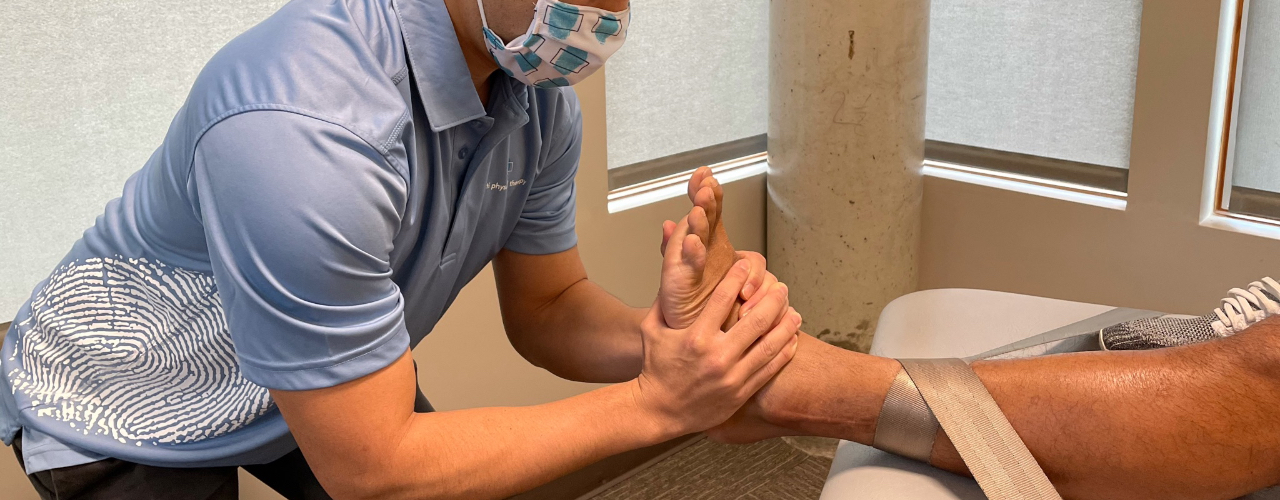Foot and Ankle Pain Relief
Why are foot and ankle problems so common?
Our feet bear the brunt of everything we do in our daily lives once we’re upright. They absorb the shock impact of all of our steps, stumbles and heavy jogging strikes.. And, of course, we often “ask” our feet to do this while wearing high heels, or other footwear with virtually no support where it’s needed. You probably won’t be able to “outrun” some level of ankle or foot pain in your lifetime, whether you’re a sports junkie or a couch potato. Ironically, both a very active lifestyle and an extremely sedentary one can lead to foot and ankle pain, and aging is often a factor as well.
In fact, the lower part of our body is a complex interplay of many bones, tendons and joints. This system of joints needs to work together. It is not uncommon for a small limitation in joint motion, or muscle weakness, to cause pain when we are standing on the problem (our feet) all day long. Our innovative care strategies at MTI Physical Therapy will help you find quick relief.
What types of conditions can be helped with physical therapy?
With the legs’ tibia and fibula bones coming together at the ankle and arching over the foot’s talus bone, problems in your feet can influence ankle pain and vice versa. Similarly, problems with your feet can put stress on your knees and throw off hip and spine alignment. For that reason, the number of problems addressed by physical therapy relating to feet and ankles is fairly substantial. Conditions include:
- Balance and mobility issues
- Plantar fasciitis
- Achilles tendonitis
- Sprained ankles
- Collapsed arches
- Non-specific foot pain
- Big Toe restrictions and hallux valgus
- Arthritis of foot and ankle
- Sports injuries
- Post-surgical rehabilitation
Your feet don’t have to hurt to be causing problems
Stiffness in muscles and joints of the ankle and foot can be pain free, but can cause mechanical problems at your knee, hip and back. If your foot doesn’t have the normal flexibility to step over it, then there is a compensation up the leg and even into the back that occurs. Often when we treat persistent knee, hip and back pain, we identify impairments in the foot and ankle that need to be treated along with the primary area of pain. Physical therapists have the training to understand these relationships and not just evaluate the painful area, but the entire biomechanical chain from your back to your toes.
What happens in physical therapy?
Our dedicated team of physical therapists are trained to conduct a thorough evaluation based on your symptoms and your medical history. They will also evaluate your walk and your ability to move your feet and ankles in various positions. Your ankle and foot contains approximately two dozen bones, 33 joints, and over 100 muscles, tendons, and ligaments. Your OMPT trained physical therapist also can assess the motion of these joints, the integrity of their ligaments and the strength of the surrounding muscles. Additionally, your functional balance can be assessed to determine if deficits are associated with your foot or your inner ear.
Once the problems have been identified, a specific treatment program is customized for your rehabilitation. Specific manual soft tissue techniques and joint mobilization can reduce your pain and get you walking normally again. Additionally, any one of these joints might be identified as hypermobile, having too much motion from a ligament injury. Therapeutic exercise can help to strengthen these ligaments, improve your balance and strengthen the muscles around the foot.
Our team of physical therapists will also teach you how to improve your posture when walking and running if gait issues are resulting from, or even causing, your foot and ankle pain.
What’s causing my foot/ankle pain?
Foot and ankle pain can occur suddenly due to an acute injury, or it can develop over time in relation to a chronic, underlying condition. According to the Mayo Clinic, there are several common causes of foot pain and ankle pain, including:
Sprains and strains:
A sprain occurs when a ligament is stretched too far or torn, while a strain occurs when a muscle or tendon is stretched too far.
Tarsal tunnel syndrome:
Tarsal tunnel syndrome occurs when the tarsal tunnel (the nerve that runs from the ankle to the foot) becomes pinched and inflamed.
Fractures:
A fracture occurs from excessive force or trauma to the bone, causing it to crack or break entirely. A fracture to the foot or ankle could result in weeks of downtime to ensure proper healing.
Plantar fasciitis:
Plantar fasciitis is associated with a weakening of the connective tissue on the bottom of your foot. This can occur from aggravated overuse, such as constant standing, improper posture, or footwear that lacks proper arch support. Stiffness or weakness in the hip and knee can also overload this area. Sensitivity of the lower back nerves can also refer pain to this area. Your OMPT trained physical therapist can determine the origin of your plantar fascia pain.
Tendinitis:
Tendinitis occurs from excessive overuse of the tendons, causing them to become inflamed for a long time. Overuse of tendons in the foot can be caused by weakness at the knee or hip. Evaluating the strength and function above the foot is a part of a thorough assessment of tendinitis in the foot, with treatment directed to these areas as needed.
Foot arches:
Your foot contains several tendons that work together to form your arch. When the tendons pull together properly, your foot will form a proper arch. However, when the tendons do not pull together properly, your foot will form a very small arch, or no arch at all. Orthotics are often used to support the arch. Additionally, muscle strengthening is necessary to reduce the reliance on footwear. We can work with you to determine your orthotic needs, including simple, off the shelf orthotics or customized orthotics made just for you. We will also work closely with your podiatrist to put together a complete rehabilitation program.
Arthritis:
Arthritis is a common inflammatory condition that affects the joints and results in pain. The most common types of Arthritis are osteoarthritis and rheumatoid arthritis.
Get started today
Don’t let foot and ankle pain slow you down! Our physical therapists at our Bellevue, Edmonds, Magnolia, Fremont, First Hill, WA physical therapy clinics are ready to help you get rid of your foot and ankle pain.
Contact MTI Physical Therapy today to schedule your appointment. We’ll help you get back on your feet in no time!



